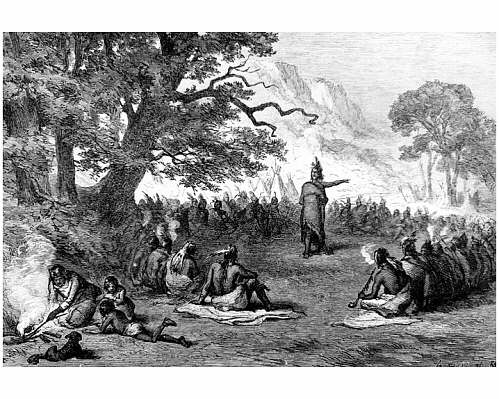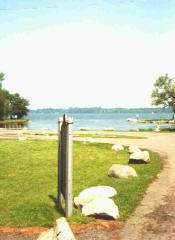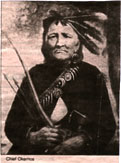|
|
|
|
Potawatomi Native North Americans whose language belongs to the Algonquian branch of the Algonquian-Wakashan linguistic stock. They are closely related to the Ojibwa and Ottawa; their traditions state that all three were originally one people. The Potawatomi were of the Eastern Woodlands area. In the early 17th cent., when first encountered by the whites, the Potawatomi lived near the mouth of Green Bay in Wisconsin. By the end of the century, however, they had been driven (probably by the Sioux) S along Lake Michigan and were settled on both sides of the southern end of the lake. After the Illinois were conquered (c.1765), they advanced into NE Illinois, S Michigan, and, later, NW Indiana. They were friendly to the French and aided them against the English. The Potawatomi supported Pontiac's Rebellion, fought against the United States in the battles headed by Little Turtle, took part in the battle of Fallen Timbers, and signed the Treaty of Greenville (1795). They sided with the British in the War of 1812. With the advancing frontier, the Potawatomi retreated westward to Iowa and Kansas, although a portion went to Walpole Island in Canada. From the reservation in Kansas where they had gathered, a large group moved (1868) to Oklahoma Indian Territory; this group, which held lands in severalty, became known as Citizen Potawatomi. Their name is also spelled Potawatami, Pottawatami, and Pottawatomi. See Ruth Landes, The Prairie Potawatomi (1970). Pontiac's Rebellion

1763-66, Native American uprising against the British just after the close of the French and Indian Wars, so called after one of its leaders, Pontiac.
Causes
The French attitude toward the Native Americans had always been more conciliatory than that of the English. French Jesuit priests and French traders had maintained friendly and generous dealings with their Native American neighbors. After conquering New France (Old Canada), the English aroused the resentment of the Western tribes by treating them arrogantly, refusing to supply them with free ammunition (as the French had done), building forts, and permitting white settlement on Native American-owned lands. Course of the War
In April, 1763, a council was held by the Native Americans on the banks of the Ecorse River near Detroit; there an attack on the fort at Detroit was planned. Pontiac's scheme was to gain admission to the garrison for himself and some of his chiefs by asking for a council with the commandant, but the Native Americans, who would be carrying weapons, were then to open a surprise attack. Major Henry Gladwin, the commandant, was warned of the plot and foiled it. However, Pontiac and his Ottawas, reinforced by Wyandots, Potawatomis, and Ojibwas, stormed the fort on May 10. The garrison was relieved by reinforcements and supplies from Niagara in the summer, but Pontiac continued to besiege it until November, when, disappointed at finding he could expect no help from the French, he retired to the Maumee River.
Fort Pitt in Pennsylvania had been warned of the uprising by a messenger from Gladwin and withstood attack until relieved by Col. Henry Bouquet. Bouquet and his forces, on their way to Fort Pitt in Aug., 1763, had been victorious in a severe engagement at Bushy Run. Meanwhile, Pontiac's allies, the Delaware, Seneca, and Shawnee tribes, captured and destroyed many British outposts, among them Sandusky, Michilimackinac, and Presque Isle. In an attempt by the British to surprise Pontiac's camp, the battle of Bloody Run was fought on July 31, 1763, with great loss to the British. The borders of Pennsylvania, Maryland, and Virginia were kept in a state of terror.
In the spring of 1764 an offensive campaign was planned by the English, and two armies were sent out, one into Ohio under Colonel Bouquet and the other to the Great Lakes under Col. John Bradstreet. Bradstreet's attempts at treaties were condemned by Gen. Thomas Gage, who had succeeded Sir Jeffery Amherst as commander in chief, and Colonel Bradstreet returned home with little achievement. Bouquet, by his campaign in Pennsylvania, brought the Delaware and the Shawnee to sue for peace, and a treaty was concluded with them by Sir William Johnson. After failing to persuade some of the tribes farther west and south to join him in rebellion, Pontiac finally completed in 1766 a treaty with Johnson and was pardoned by the English. Francis Parkman's History of the Conspiracy of Pontiac (1851, 10th rev. ed. 1913), although it contains certain inaccuracies, is the classic work. See also H. H. Peckham, Pontiac and the Indian Uprising (1947). Chief Pontiac fl. 1760-66, Ottawa chief. He may have been the chief met by Robert Rogers in 1760 when Rogers was on his way to take possession of the Western forts for the English. Although the Native American uprising against the English colonists just after the French and Indian Wars is known as Pontiac's Rebellion or Pontiac's Conspiracy, Pontiac's role is uncertain. He definitely was present at the siege of Detroit, and encouraged other tribes to fight the British, but most of the actual fighting and strategy was probably planned independently by other Native American leaders. After the rebellion had failed and a treaty had been concluded (1766), Pontiac is supposed to have gone west and to have been murdered by Illinois at Cahokia. This story is, however, accepted by few authorities. See bibliography under Pontiac's Rebellion.
A pleasant tradition, unsupported by history, says that Pontiac once lived on Apple Island here in Orchard Lake. This great Indian chief was born around 1720, probably in the Ottawa village on the Detroit River. A friend of the French, Pontiac was angered by the British rule which began in 1760, and plotted its overthrow. In 1763 he led the Indians of the area in an attack on Detroit while other tribes, who were inspired by him, rose against the British in the West and overwhelmed every fort save Fort Pitt and Niagara. Pontiac's siege of Detroit failed. With it, this greatest of Indian uprisings also failed. In 1769 Pontiac was killed by another Indian in Illinois. He probably was buried in St. Louis, Missouri. The city of Pontiac was named in his honor.

 Chief Okemos was the nephew of Chief Pontiac, chief of the Chippewa Indians. He is first mentioned in 1796, when he took to the warpath. Okemos and 16 other braves left the Mason area and enlisted with the British. Chief Okemos was the nephew of Chief Pontiac, chief of the Chippewa Indians. He is first mentioned in 1796, when he took to the warpath. Okemos and 16 other braves left the Mason area and enlisted with the British.
One morning they lay in ambush near a road cut for passage of American Army and supply wagons. A group of American troops approached and the Indians immediately attacked. Many other American troops joined the battle and the Indians were defeated. They suffered many sword cuts and gashes.
Three days after the battle, squaws found only three men alive. Okemos was one of the survivors. He was nursed for many months before he regained his health. He always had terrible wounds on his forehead. People could put three fingers into the scar on his forehead. One gash on his back never healed. The old records of the pioneers always mentioned this gash. The Indians felt that he must have been favored by the Great Spirit to survive and named him Chief out of respect for his great courage.
Okemos had enough of fighting and shortly after his recovery he and other chiefs signed a peace treaty with Lewis Cass, who was the Territorial Governor on Michigan. (Have you read the biography of Elizabeth Cass in our biography section?) The peace treaty was faithfully kept.
Chief Okemos camped mostly in the area where Okemos is located. He was also a frequent visitor in Mason and often ate with the early settlers. You could tell if he was around because he always played his pipe or flute in the early morning.
Chief Okemos was just five feet tall. He usually wore a blanket coat with a belt and had a steel pipe hatchet tomahawk and a long hunting knife. He sometimes painted his face with vermillion on his cheeks and forehead and over his eyes. Chief Okemos died in 1858 at an Indian settlement near Ionia.
Citizen Potawatomi Nation
Read the general summary of this Oklahoma nation which includes history,
culture, tribal government, the reservation (with an enlargeable map), and
language. You can keep current with the news and issues of the day, check
out past news articles, access information about the tribe's departments and
programmes, and follow related links from this 197-page website.
http://www.potawatomi.org/
Hannahville Potawatomi
Northern Michigan is home to this tribe whose school maintains the website
you'll find here. Much of it is under construction yet, but judging by the
topics listed it will eventually be a valuable source of information. You'll
need to poke around to see what's available now. Some pages are slow to load
due to the background graphics.
http://www.danville.net/~grf/pdc3.html
Prairie Band Potawatomi
An excellent website with oodles of information for you about this Kansas
tribe's history, culture, and present circumstances. There is a section
which contains reviews of books by, and pertaining to, the Potawatomi
people. Each review is linked to the full online text of the publication.
You'll also find a genealogy section.
http://www.ukans.edu/~kansite/pbp/homepage.html
Citizen Potawatomi - http://redrival.com/nishnabek
Unofficial page includes history, language, art, and other resources.
Citizen Potawatomi Nation - http://www.potawatomi.org/
Official site of this Oklahoma tribe includes news, links, and information on language, art, and culture.
Pokagon Band of Potawatomi - http://www.pokagon.com/
Official homepage of this Michigan band offers basic information about the tribe and its members.
Potawatomi - http://www.geocities.com/bigorrin/pota.htm
Background information and indexed links about Potawatomi community, history, language, and genealogy.
Potawatomi Web - http://www.ukans.edu/~kansite/pbp/homepage.html
Presents various materials pertaining to Potawatomi language and culture, particularly as it relates to the Prairie Band.
Prairie Band of Potawatomi - http://www.pbpindiantribe.com/
Homepage of this Kansas tribe includes cultural, historical, and government information, a section about the casino, and links.
The Potawatomi - http://ctct.essortment.com/potawatominatio_rkyt.htm
Article from PageWise. Will open more windows when you try to leave.
BoDeWadMi - http://4directions.org/BoDeWadMi/
Hypertext grammar of Potawatomi, also with a Potawatomi song and prayer.
Potawatomi (Bode'wadmi) - http://www.geocities.com/bigorrin/pota.htm
Information and links about this Algonquian language and the culture, history, and genealogy of the people who speak it.
Potawatomi Web: Language - http://www.ukans.edu/~kansite/pbp/talk/home.html
Potawatomi language resource with orthography, texts, and sociolinguistic discussion of revitalization efforts.
Potawatomilang.org - http://www.potawatomilang.org
Website dedicated to Potawatomi language issues. With a forum and a growing collection of language reference materials. |
|
|
|
|
|
 Native American Nations
Native American Nations
